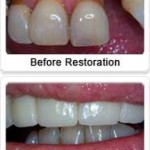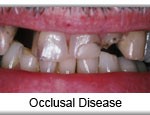A lost tooth can be a subject of great anxiety or “no big deal” if you grew up in a household where both your parents wore complete dentures by the age of thirty. People can lose teeth due to trauma, periodontal disease, failed root canals, cracked teeth, and extensive decay. Regardless, losing a tooth can create esthetic issues – especially if it’s a front tooth – but create long-term problems to adjacent tooth structures.
Should I replace a lost tooth? The answer is almost always: “Yes,” even if it’s a back tooth you don’t see. The masticatory complex was designed to function as a unit. How efficient is riding a bicycle with spokes on the wheel missing? It puts more stress on the other spokes; hit a bump, and you will be picking yourself and a bent wheel off the ground. When one loses a back tooth, the adjacent teeth are subjected to a greater load as you eat. Amalgams, white bonded fillings, and crowns are great replacements for missing or lost tooth structure, but mastication muscles are strong and put more stress on these artificial materials. Periodontal disease, an infection of the tissues surrounding a tooth, not only causes infection and bleeding of gum tissues but often causes the bone around teeth to shrink away as a result of chronic inflammation. Periodontally infected teeth get loose because there is less bone support around them. Are our fence posts stronger if they are buried three inches or three feet into the ground? Lose a tooth, for whatever reason, and adjacent teeth that already suffer from periodontal disease can literally be loosened to the point of pain, increased infection, and ultimate tooth loss.
When one loses a tooth, the associated tooth structures also become compromised. A missing tooth will cause the opposing tooth to supra-erupt into the missing space. Adjacent teeth also “fall” or “tilt” into the hole. Eating, clenching and sliding the jaw left, right, backward, and forward now creates a traumatic occlusion as these teeth are in unintended positions and take the brunt of the strong, strong muscles used to chew. Hence, these teeth become more prone to breaking and periodontal disease, as already discussed. Food also begins to collect in the gaps created by these moving and tilted teeth. Anywhere food impacts or collects becomes more cavity-prone. Food impaction also starts the “domino effect” of periodontal disease.
The American public spends billions of dollars annually on looking younger. Begin to lose back teeth – that support the muscles and structures in your face – and you will begin to look much older than your true age. Put, missing teeth create wrinkles.
When a tooth is lost, and no other treatment in the area is performed, the bone shrinks away. This creates esthetic issues should the area be restored with fixed bridges, partial dentures, or implants. Implants require bone to support them and sometimes cannot be placed if not addressed somewhat soon after tooth loss. People that lose all their teeth early in life become “dental cripples” in their senior years. As bone loss progresses, gums used to support complete dentures or removable partial dentures shrinks away and makes them fit less optimally. Dentures are meant to be worn, not carried in one’s purse, and only used to go to church on Sunday.
What’s the best way to replace a missing tooth? There are several options with their own advantages, disadvantages, and varying degrees of longevity, comfort, and costs. This is a topic for another article. Most importantly, see your dentist, ask questions, and be informed. All dental care should be custom-tailored to meet your specific situation and needs.
Dr. Kelly Jorn Cook, DDS, provides Dentistry for Seniors for comprehensive care for maintaining function and good hygiene that can prevent tooth loss and other oral health problems.


